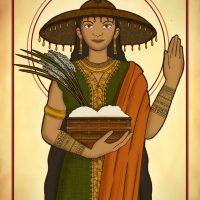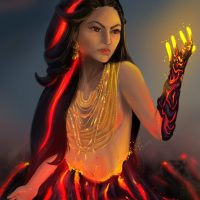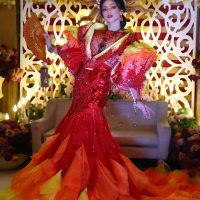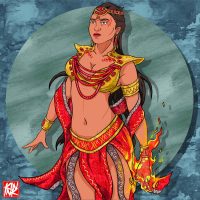Lalahon : Goddess of the Harvest
Listen
At a glance
| Description | |
|---|---|
| Origin | Philippine Mythology |
| Classification | Gods |
| Family Members | N/A |
| Region | Philippines |
| Associated With | Harvest, Fire, Volcanoes |
Lalahon
Introduction
Lalahon emerges as a prominent figure within Visayan mythology, esteemed as the deity presiding over bountiful harvests and agriculture. Across the expanse of Filipino folklore, this ancient divinity occupies a notable position. Yet, the comprehension of Lalahon has often been clouded by misinterpretations and historical inaccuracies. Originating from the ancient Visayan region, her presence resonated profoundly within local communities, serving as a poignant reminder of the delicate equilibrium between nature’s destructive forces and its nurturing aspects. Lalahon, alternately recognized as Alunsina or Laon, stands as a cornerstone in the rich tapestry of the Philippines’ cultural and spiritual heritage.
Physical Traits
In the myths, there are no specific physical descriptions of Lalahon, but she is often depicted in connection to her domain. As the goddess of harvest and agriculture, she is symbolically linked to the fertility and abundance of the land. Lalahon typically appears as a stunning woman radiating with fiery energy. Her features include flowing, fiery red hair, reflecting her association with fire and volcanic eruptions. Her complexion may suggest volcanic activity, appearing scorched or blackened. Her eyes glow with a vibrant orange or red light, mirroring the fire within her. Lalahon carries herself with a fierce and regal demeanor, exuding authority and confidence befitting her role as a powerful deity. Some interpretations depict her adorned with volcanic rocks or molten lava as jewelry, emphasizing her connection to the earth’s fiery depths. In certain tales, she emerges from the volcano itself, embodying its raw and untamed power.
Family
In the myths, Lalahon’s family remains a subject of speculation rather than explicit mention. Nonetheless, her deep affinity with the natural world often intertwines her narrative with other nature-centric deities in Philippine mythology. The specifics of Lalahon’s familial connections remain debated due to the fragmented nature of pre-colonial Philippine mythos. While some accounts offer no direct familial ties, others propose potential associations. Some narratives suggest a link between Lalahon and Mount Kanlaon, the volcano believed to be her sacred abode in certain regions. Interpretations vary, with some suggesting Lalahon as a daughter or embodiment of Bathala’s dominion over nature, thus weaving her into the wider pantheon. Lalahon may have been intertwined with, or even perceived as a manifestation of, the diwata—spirits intimately connected to specific natural elements. These interpretations, however, are not necessarily exclusive and may reflect diverse regional perspectives and individual beliefs within distinct communities.
Other names
In the vibran Visayan folklore, Lalahon, the revered deity of bountiful harvests and agriculture, is known by an array of names such as Laon, Malaon, Raom, Makapatag, Laon Sina, Alunsina, and Kanlaon. Each name encapsulates a unique essence, offering diverse insights into the goddess’s character and influence. Beyond the confines of a single appellation, Lalahon’s identity unfolds across various regions and within specific folk narratives. She may be hailed as Laon, a succinct rendition of her primary name, or as Mag-alon, signifying her dominion over fire. Alternatively, the title Apo Laon conveys reverence and respect, highlighting her esteemed status as a venerable and powerful deity.
Powers and Abilities
Lalahon, revered as the goddess presiding over fire, volcanoes, and harvest, holds sway over the natural realm, wielding immense power that encompasses both nurturing and destructive forces. She commands fire with ease, igniting eruptions and quelling volcanic unrest, while also manipulating seismic activity, influencing earthquakes, tremors, and the earth’s movements. Governed by Lalahon, fertility flourishes, fostering the growth and abundance of vital crops. Despite her potential for devastation, she assumes a protective role, safeguarding the land’s resilience and imparting lessons about respecting its power. It’s crucial to recognize that Lalahon embodies not just destruction, but also the cyclical essence of life—a process where destruction paves the path for renewal and growth. Hailed as the goddess of harvest and agriculture, Lalahon is venerated for her role in bestowing prosperity upon the farming communities of the Visayas, where she is intimately linked to concepts of fertility and abundance, symbolizing the flourishing crops that underpin livelihoods.
Modern Day Influence
Lalahon’s enduring presence resonates within contemporary culture, upheld through archaeological and historical discoveries that continuously unveil her legacy. Despite the relentless march of time and the onset of modernity, veneration for Lalahon persists, particularly among rural and indigenous communities where agriculture remains fundamental. Through oral traditions and folk tales, the knowledge and cultural significance of this ancient deity persist, ensuring her memory endures.
Moreover, Lalahon frequently finds her place in various creative expressions, from artwork to literature, inspiring contemporary artists and writers alike. Though offerings and rituals have evolved from the pre-colonial era, some communities still honor Lalahon and other nature spirits through festivals and ceremonies. Moreover, her association with nature serves as a poignant reminder of the imperative to respect and safeguard the environment, especially amidst mounting environmental challenges. Lalahon’s lasting impact stands as a testament to the enduring potency of Philippine mythology and the profound bond between the people and their land, fostering a deeper understanding of both Lalahon and other divine entities.
Related Images
Frequently Asked Questions
What is lorem Ipsum?
I am text block. Click edit button to change this text. Lorem ipsum dolor sit amet, consectetur adipiscing elit. Ut elit tellus, luctus nec ullamcorper mattis, pulvinar dapibus leo.
What is lorem Ipsum?
I am text block. Click edit button to change this text. Lorem ipsum dolor sit amet, consectetur adipiscing elit. Ut elit tellus, luctus nec ullamcorper mattis, pulvinar dapibus leo.
What is lorem Ipsum?
I am text block. Click edit button to change this text. Lorem ipsum dolor sit amet, consectetur adipiscing elit. Ut elit tellus, luctus nec ullamcorper mattis, pulvinar dapibus leo.
What is lorem Ipsum?
I am text block. Click edit button to change this text. Lorem ipsum dolor sit amet, consectetur adipiscing elit. Ut elit tellus, luctus nec ullamcorper mattis, pulvinar dapibus leo.
What is lorem Ipsum?
I am text block. Click edit button to change this text. Lorem ipsum dolor sit amet, consectetur adipiscing elit. Ut elit tellus, luctus nec ullamcorper mattis, pulvinar dapibus leo.












